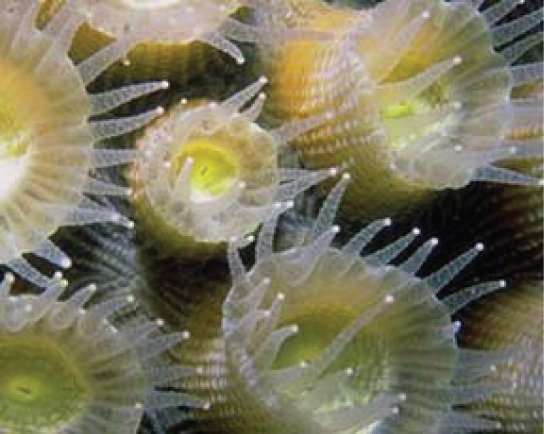8.19B: Protists as Primary Producers, Food Sources, and Symbionts
- Page ID
- 9850
\( \newcommand{\vecs}[1]{\overset { \scriptstyle \rightharpoonup} {\mathbf{#1}} } \)
\( \newcommand{\vecd}[1]{\overset{-\!-\!\rightharpoonup}{\vphantom{a}\smash {#1}}} \)
\( \newcommand{\id}{\mathrm{id}}\) \( \newcommand{\Span}{\mathrm{span}}\)
( \newcommand{\kernel}{\mathrm{null}\,}\) \( \newcommand{\range}{\mathrm{range}\,}\)
\( \newcommand{\RealPart}{\mathrm{Re}}\) \( \newcommand{\ImaginaryPart}{\mathrm{Im}}\)
\( \newcommand{\Argument}{\mathrm{Arg}}\) \( \newcommand{\norm}[1]{\| #1 \|}\)
\( \newcommand{\inner}[2]{\langle #1, #2 \rangle}\)
\( \newcommand{\Span}{\mathrm{span}}\)
\( \newcommand{\id}{\mathrm{id}}\)
\( \newcommand{\Span}{\mathrm{span}}\)
\( \newcommand{\kernel}{\mathrm{null}\,}\)
\( \newcommand{\range}{\mathrm{range}\,}\)
\( \newcommand{\RealPart}{\mathrm{Re}}\)
\( \newcommand{\ImaginaryPart}{\mathrm{Im}}\)
\( \newcommand{\Argument}{\mathrm{Arg}}\)
\( \newcommand{\norm}[1]{\| #1 \|}\)
\( \newcommand{\inner}[2]{\langle #1, #2 \rangle}\)
\( \newcommand{\Span}{\mathrm{span}}\) \( \newcommand{\AA}{\unicode[.8,0]{x212B}}\)
\( \newcommand{\vectorA}[1]{\vec{#1}} % arrow\)
\( \newcommand{\vectorAt}[1]{\vec{\text{#1}}} % arrow\)
\( \newcommand{\vectorB}[1]{\overset { \scriptstyle \rightharpoonup} {\mathbf{#1}} } \)
\( \newcommand{\vectorC}[1]{\textbf{#1}} \)
\( \newcommand{\vectorD}[1]{\overrightarrow{#1}} \)
\( \newcommand{\vectorDt}[1]{\overrightarrow{\text{#1}}} \)
\( \newcommand{\vectE}[1]{\overset{-\!-\!\rightharpoonup}{\vphantom{a}\smash{\mathbf {#1}}}} \)
\( \newcommand{\vecs}[1]{\overset { \scriptstyle \rightharpoonup} {\mathbf{#1}} } \)
\( \newcommand{\vecd}[1]{\overset{-\!-\!\rightharpoonup}{\vphantom{a}\smash {#1}}} \)
Protists function as sources of food for organisms on land and sea.
- Give examples of how protists act as primary producers
Key Points
- Photosynthetic protists serve as producers of nutrition for other organisms.
- Protists like zooxanthellae have a symbiotic relationship with coral reefs; the protists act as a food source for coral and the coral provides shelter and compounds for photosynthesis for the protists.
- Protists feed a large portion of the world’s aquatic species and conduct a quarter of the world’s photosynthesis.
- Protists help land-dwelling animals such as cockroaches and termites digest cellulose.
Key Terms
- zooxanthella: an animal of the genus Symbiodinium, a yellow dinoflagellate, notably found in coral reefs
- primary producer: an autotroph organism that produces complex organic matter using photosynthesis or chemosynthesis
Primary Producers/Food Sources
Protists function in various ecological niches. Some protist species are essential components of the food chain and are generators of biomass.
Protists are essential sources of nutrition for many other organisms. In some cases, as in plankton, protists are consumed directly. Alternatively, photosynthetic protists serve as producers of nutrition for other organisms. For instance, photosynthetic dinoflagellates called zooxanthellae use sunlight to fix inorganic carbon. In this symbiotic relationship, these protists provide nutrients for the coral polyps that house them, giving corals a boost of energy to secrete a calcium carbonate skeleton. In turn, the corals provide the protists with a protected environment and the compounds needed for photosynthesis. This type of symbiotic relationship is important in nutrient-poor environments. Without dinoflagellate symbionts, corals lose algal pigments in a process called coral bleaching and they eventually die. This explains why reef-building corals do not reside in waters deeper than 20 meters: insufficient light reaches those depths for dinoflagellates to photosynthesize.

The protists themselves and their products of photosynthesis are essential, directly or indirectly, to the survival of organisms ranging from bacteria to mammals. As primary producers, protists feed a large proportion of the world’s aquatic species. (On land, terrestrial plants serve as primary producers. ) In fact, approximately one-quarter of the world’s photosynthesis is conducted by protists, particularly dinoflagellates, diatoms, and multicellular algae.

Protists do not only create food sources for sea-dwelling organisms. Certain anaerobic parabasalid species exist in the digestive tracts of termites and wood-eating cockroaches where they contribute an essential step in the digestion of cellulose ingested by these insects as they bore through wood.
LICENSES AND ATTRIBUTIONS
CC LICENSED CONTENT, SHARED PREVIOUSLY
- Curation and Revision. Provided by: Boundless.com. License: CC BY-SA: Attribution-ShareAlike
CC LICENSED CONTENT, SPECIFIC ATTRIBUTION
- OpenStax College, Biology. October 16, 2013. Provided by: OpenStax CNX. Located at: http://cnx.org/content/m44617/latest...ol11448/latest. License: CC BY: Attribution
- endosymbiotic. Provided by: Wiktionary. Located at: en.wiktionary.org/wiki/endosymbiotic. License: CC BY-SA: Attribution-ShareAlike
- plankton. Provided by: Wiktionary. Located at: en.wiktionary.org/wiki/plankton. License: CC BY-SA: Attribution-ShareAlike
- OpenStax College, Groups of Protists. October 16, 2013. Provided by: OpenStax CNX. Located at: http://cnx.org/content/m44617/latest...e_23_03_16.jpg. License: CC BY: Attribution
- OpenStax College, Groups of Protists. October 16, 2013. Provided by: OpenStax CNX. Located at: http://cnx.org/content/m44617/latest...e_23_03_15.jpg. License: CC BY: Attribution
- OpenStax College, Biology. October 16, 2013. Provided by: OpenStax CNX. Located at: http://cnx.org/content/m44619/latest...ol11448/latest. License: CC BY: Attribution
- OpenStax College, Biology. November 11, 2013. Provided by: OpenStax CNX. Located at: http://cnx.org/content/m44619/latest...ol11448/latest. License: CC BY: Attribution
- zooxanthella. Provided by: Wiktionary. Located at: en.wiktionary.org/wiki/zooxanthella. License: CC BY-SA: Attribution-ShareAlike
- primary producer. Provided by: Wiktionary. Located at: en.wiktionary.org/wiki/primary_producer. License: CC BY-SA: Attribution-ShareAlike
- OpenStax College, Groups of Protists. October 16, 2013. Provided by: OpenStax CNX. Located at: http://cnx.org/content/m44617/latest...e_23_03_16.jpg. License: CC BY: Attribution
- OpenStax College, Groups of Protists. October 16, 2013. Provided by: OpenStax CNX. Located at: http://cnx.org/content/m44617/latest...e_23_03_15.jpg. License: CC BY: Attribution
- OpenStax College, Ecology of Protists. October 16, 2013. Provided by: OpenStax CNX. Located at: http://cnx.org/content/m44619/latest...04_02abcde.jpg. License: CC BY: Attribution
- OpenStax College, Ecology of Protists. October 16, 2013. Provided by: OpenStax CNX. Located at: http://cnx.org/content/m44619/latest...e_23_04_01.jpg. License: CC BY: Attribution


